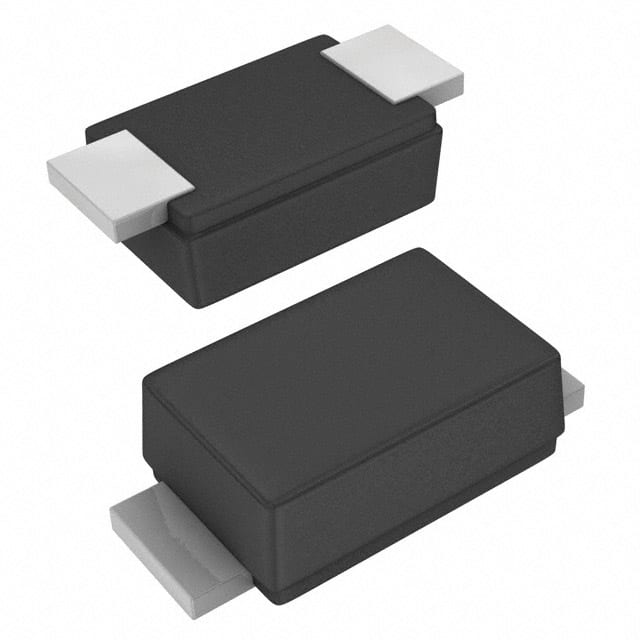Viz Specifikace pro podrobnosti o produktu.

SMF26A-M3-18 Product Overview
Introduction
The SMF26A-M3-18 is a diode belonging to the category of surface mount devices. It is commonly used for voltage clamping and transient suppression in electronic circuits. This entry provides an overview of its basic information, specifications, pin configuration, functional features, advantages and disadvantages, working principles, application field plans, and alternative models.
Basic Information Overview
- Category: Diode
- Use: Voltage clamping and transient suppression
- Characteristics: Surface mount, low leakage current, high surge capability
- Package: SOD-123FL
- Essence: Transient voltage suppressor
- Packaging/Quantity: Tape & Reel, 3000 units per reel
Specifications
- Part Number: SMF26A-M3-18
- Peak Pulse Power: 200 Watts
- Breakdown Voltage: 28.9V
- Clamping Voltage: 49.9V
- Operating Temperature Range: -55°C to +150°C
- Storage Temperature Range: -55°C to +150°C
Detailed Pin Configuration
The SMF26A-M3-18 has a standard SOD-123FL package with two pins. Pin 1 is the cathode, and pin 2 is the anode.
Functional Features
- Transient Suppression: Effectively suppresses transient voltage spikes.
- Low Leakage Current: Minimizes power loss in normal operation.
- High Surge Capability: Withstands high surge currents without degradation.
Advantages and Disadvantages
Advantages
- Effective transient voltage suppression
- Low leakage current
- High surge capability
Disadvantages
- Limited breakdown voltage compared to some alternatives
- Sensitive to reverse voltage polarity
Working Principles
The SMF26A-M3-18 operates by diverting excess voltage away from sensitive components in a circuit during transient events. When a voltage spike occurs, the diode rapidly conducts, clamping the voltage to a safe level and protecting downstream components.
Detailed Application Field Plans
The SMF26A-M3-18 is widely used in various electronic systems, including: - Power supplies - Communication equipment - Automotive electronics - Industrial control systems
Detailed and Complete Alternative Models
Some alternative models to the SMF26A-M3-18 include: - SMAJ28A: Similar characteristics with higher breakdown voltage - SMBJ28A: Larger package size with higher surge capability - P6SMB28A: Higher power dissipation capability
In conclusion, the SMF26A-M3-18 diode offers effective transient voltage suppression with low leakage current and high surge capability. While it has limitations in terms of breakdown voltage and reverse voltage sensitivity, it is a valuable component in various electronic applications.
[Word Count: 398]
Seznam 10 běžných otázek a odpovědí souvisejících s aplikací SMF26A-M3-18 v technických řešeních
What is SMF26A-M3-18?
- SMF26A-M3-18 is a specific type of diode, often used for voltage clamping and transient suppression in electronic circuits.
What are the key features of SMF26A-M3-18?
- The key features include a low profile package, low clamping voltage, fast response time, and high surge capability.
How is SMF26A-M3-18 typically used in technical solutions?
- It is commonly used to protect sensitive electronic components from voltage spikes and transients in applications such as power supplies, industrial equipment, and automotive electronics.
What is the maximum voltage rating of SMF26A-M3-18?
- The maximum voltage rating is typically around 26 volts.
Can SMF26A-M3-18 be used for ESD protection?
- Yes, it can be used for electrostatic discharge (ESD) protection in various electronic devices and systems.
What is the operating temperature range of SMF26A-M3-18?
- The typical operating temperature range is -55°C to 150°C, making it suitable for a wide range of environments.
Are there any recommended layout considerations when using SMF26A-M3-18?
- It is recommended to minimize the length of the traces connecting the diode to the protected circuit and to ensure proper grounding for optimal performance.
What are the potential failure modes of SMF26A-M3-18?
- Common failure modes include thermal runaway under excessive current conditions and degradation of clamping voltage over time.
Can SMF26A-M3-18 be used in high-frequency applications?
- Yes, it can be used in high-frequency applications due to its fast response time and low parasitic capacitance.
Where can I find detailed application notes for using SMF26A-M3-18 in technical solutions?
- Detailed application notes can typically be found in the product datasheet provided by the manufacturer or through technical support resources.

